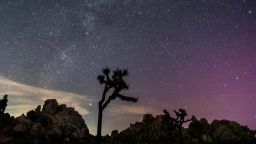Science
Orionid Meteor Shower Peaking This Week: What to Expect

The Orionid meteor shower is set to dazzle sky-gazers globally this week, with its peak occurring at 20:00 ET on Monday. This annual celestial event produces bright trails of light as meteors streak across the night sky, with some even appearing as fireballs. According to EarthSky, viewers can expect to see between 10 to 20 meteors per hour under optimal viewing conditions.
One of the unique aspects of this year’s shower is its coinciding with a new moon, as noted by The Old Farmer’s Almanac. With the moon out of sight, the visibility of the meteors will not be hindered by moonlight. Robert Lunsford, fireball report coordinator for the American Meteor Society, emphasized that the Orionids do not have a sharply defined peak. “If you happen to get clouded out on that night, don’t despair,” he advised. “Head on out the next night, next couple of nights even, and you’ll see almost the same activity.”
Viewing Conditions and Meteor Origins
For the best experience, Lunsford recommends looking towards the southern sky around 22:00 on Monday or from 04:00 to 05:00 on Tuesday morning, local time. The meteors originate from the Orion constellation, and their fast-paced nature means that most meteors will last only a fraction of a second. However, brighter meteors may leave persistent smoke trails, providing a stunning visual effect.
This year, observers might also witness activity from another meteor shower, the Southern Taurids, which is expected to peak on November 4-5. Lunsford described the unique interaction between these two showers: “It’s kind of like they’re doing battle,” he stated. The slower-moving Taurids originate from the Taurus constellation, while the Orionids race across the sky from the east.
The Orionid meteor shower is a result of Earth’s passage through debris left by comet 1P/Halley. According to NASA, Halley’s comet crosses Earth’s orbit twice, first in October, leading to the Orionids, and again in early May, causing the Eta Aquariid shower. Halley’s comet last appeared in 1986, and its next return is anticipated in 2061.
Upcoming Meteor Showers and Celestial Events
Sky enthusiasts can look forward to additional meteor showers later this year. The American Meteor Society and EarthSky provide peak dates for these events, allowing stargazers to plan their observations accordingly.
Additionally, two more supermoons are scheduled for later this year, offering more opportunities for breathtaking celestial displays. Each of these events contributes to the rich tapestry of our night sky and provides a chance for both casual viewers and avid astronomers to connect with the cosmos.
As the Orionid meteor shower lights up the skies, it promises to be a captivating experience for all who take the time to observe this extraordinary natural phenomenon.
-

 Lifestyle5 months ago
Lifestyle5 months agoLibraries Challenge Rising E-Book Costs Amid Growing Demand
-

 Sports4 months ago
Sports4 months agoTyreek Hill Responds to Tua Tagovailoa’s Comments on Team Dynamics
-

 Sports4 months ago
Sports4 months agoLiverpool Secures Agreement to Sign Young Striker Will Wright
-

 Lifestyle4 months ago
Lifestyle4 months agoSave Your Split Tomatoes: Expert Tips for Gardeners
-

 Lifestyle4 months ago
Lifestyle4 months agoPrincess Beatrice’s Daughter Athena Joins Siblings at London Parade
-

 Science4 months ago
Science4 months agoSan Francisco Hosts Unique Contest to Identify “Performative Males”
-

 World4 months ago
World4 months agoWinter Storms Lash New South Wales with Snow, Flood Risks
-

 Science5 months ago
Science5 months agoTrump Administration Moves to Repeal Key Climate Regulation
-

 Business5 months ago
Business5 months agoSoFi Technologies Shares Slip 2% Following Insider Stock Sale
-

 Science5 months ago
Science5 months agoNew Tool Reveals Link Between Horse Coat Condition and Parasites
-

 Sports4 months ago
Sports4 months agoElon Musk Sculpture Travels From Utah to Yosemite National Park
-

 Science5 months ago
Science5 months agoNew Study Confirms Humans Transported Stonehenge Bluestones









